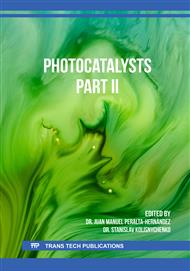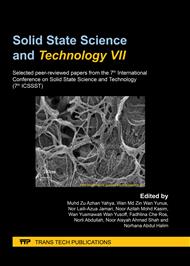[1]
Y. Tang, X. Peng, W. Yang, Y. Zhang, M.Yin, Y. Liang, Z.Dong, Emerging Pollutants – Part I: Occurrence, Fate and Transport, Water Environment Research 89 (2017) 1810-1828.
DOI: 10.2175/106143017x15023776270665
Google Scholar
[2]
M. Naushad, E. Lichtfouse, Green Materials For Wastewater Treatment, Springer Switzerland, (2019).
Google Scholar
[3]
R. Saravanan, F. Gracia, A. Stephen, Nanocomposites for Visible Light-induced Photocatalysis, Springer International Publishing, (2017).
Google Scholar
[4]
A. I. Ahmed, A. A. Ibrahim, M. S. Adly, Application of Nanostructured Graphene Oxide / Titanium Dioxide Composites for Photocatalytic Degradation of Methylene Blue Dye under UV-visible Light, Int. J. Mod. Chem. 8(1) (2016) 27-37.
Google Scholar
[5]
K. Nakata, A. Fujishima, TiO2 photocatalysis: Design and pplications, J. Photochem. Photobiol. C Photochem. Rev. 13(3) (2012) 169–189.
Google Scholar
[6]
H. Atout, M.G. Álvarez, D. Chebli, A. Bouguettoucha, D. Tichit, J. Llorca, F. Medina, Enhanced photocatalytic degradation of methylene blue: Preparation of TiO2 /reduced graphene oxide nanocomposites by direct sol-gel and hydrothermal methods, Mater. Res. Bull. 95 (2017) 578-587.
DOI: 10.1016/j.materresbull.2017.08.029
Google Scholar
[7]
V. Loryuenyong, J. Charoensuk, R. Charupongtawitch, A. Usakulwattana, A. Buasri, Kinetics of Photocatalytic Degradation of Methylene Blue by TiO2 -Graphene Nanocomposites,J. Nanosci. Nanotechnol. 16(1) (2016) 296–302.
DOI: 10.1166/jnn.2016.11612
Google Scholar
[8]
Q. Gao, Z. Liu, FeWO4 nanorods with excellent UV–Visible light photocatalysis, Prog. Nat. Sci. Mater. Int. 27(5) (2017) 556–560.
Google Scholar
[9]
S. Mallakpour, M. Dinari, M. Hatami, Dispersion of surface-modified nano-Fe3O4 with poly(vinyl alcohol) in chiral poly(amide-imide) bearing pyromellitoyl-bis-l-phenylalanine segments, J. Mater. Sci. 50(7) (2015) 2759–2767.
DOI: 10.1007/s10853-015-8831-5
Google Scholar
[10]
A. Timoumi, S. N. Alamri, H. Alamri, The development of TiO2-graphene oxide nano composite thin films for solar cells, Results Phys. (11) (2018) 46–51.
DOI: 10.1016/j.rinp.2018.06.017
Google Scholar
[11]
F. Mbarki, F. Ammari, A. B. H. Amor, F. Meganem, Functional groups grafed on poly(vinyl chloride)-evaluation of new modifed polymers in metal ions adsorption, Polimery/Polymers 62(35) (2017)109–117.
DOI: 10.14314/polimery.2017.109
Google Scholar
[12]
A. León, FTIR and Raman Characterization of TiO2 Nanoparticles Coated with Polyethylene Glycol as Carrier for 2-Methoxyestradiol, Appl. Sci. 7(1) (2017) 49.
DOI: 10.3390/app7010049
Google Scholar
[13]
M. S. A. Sher Shah, A. R. Park, K. Zhang, J. H. Park, P. J. Yoo, Green synthesis of biphasic TiO2-reduced graphene oxide nanocomposites with highly enhanced photocatalytic activity, ACS Appl. Mater. Interfaces 4 (8) (2012) 3893–3901.
DOI: 10.1021/am301287m
Google Scholar
[14]
S. Kumari, A. Shekhar, D. D. Pathak, Graphene oxide-TiO2 composite: An efficient heterogeneous catalyst for the green synthesis of pyrazoles and pyridines, New J. Chem. 40(6) (2016) 5053–5060.
DOI: 10.1039/c5nj03380b
Google Scholar
[15]
U. Naknikham, V. Boffa, G. Magnacca, A. Qiao, L. R. Jensen, Y. Yue, Mutual-stabilization in chemically bonded graphene oxide-TiO2 heterostructures synthesized by a sol-gel approach, RSC Adv. 7(65) 41217–41227.
DOI: 10.1039/c7ra07472g
Google Scholar
[16]
C. Patomnetikul, S. Thongtem, S. Narksitipan, Characterization of GO and TiO2-GO Composites Prepared by using Microwave Technique, Int. Conf. Exp. Mech. 2013 Twelfth Asian Conf. Exp. Mech. 9234 (2014) 1–5.
DOI: 10.1117/12.2054142
Google Scholar
[17]
Y. Liu, D. Zhang, The preparation of reduced graphene oxide-TiO2composite materials towards transparent, strain sensing and photodegradation multifunctional films, Compos. Sci. Technol. 137 (2016) 102–108.
DOI: 10.1016/j.compscitech.2016.10.025
Google Scholar
[18]
V. R. Posa, V. Annavaram, J. R. Koduru, P. Bobbala, V. Madhavi, A. R. Somala, Preparation of graphene–TiO2 nanocomposite and photocatalytic degradation of Rhodamine-B under solar light irradiation, J. Exp. Nanosci. (11)(9) (2016) 722–736.
DOI: 10.1080/17458080.2016.1144937
Google Scholar




